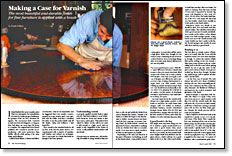Making a Case for Varnish
The most beautiful and durable finish for fine furniture is applied with a brush
Synopsis: Frank Pollaro wanted to give a complex piece he’d just completed a more protective finish than French polishing affords. Using the technique he explains here, you can brush on varnish and get a deep, clear and brilliant finish that looks sprayed-on. He introduces the article with information about varnish and how to select a good brush. Then he gets into the details of brushing it on. He rubs out and polishes the finish, and he shares information on what types of sandpaper and wetting agents he uses. A side explanation addresses how to fill porous, open-grained woods.
I’d just finished the most complex piece I had ever attempted, the reproduction of a desk by Emile-Jacques Ruhlmann, the greatest of the Art Deco furniture designers. The curvaceous desk, veneered in amboyna burl and shagreen, or sting-ray skin, had taken me more than 300 hours to complete. The original had been French polished, but I wanted to provide my reproduction with more protection than shellac affords while giving it the same clarity and brilliance.
I asked Frank Klausz, a friend and fellow woodworker, what tie recommended, and he suggested that I use varnish. I experimented on scrap boards until I was satisfied with the results. And then I varnished the desk. It was the perfect finish with all the depth, clarity and brilliance I had hoped for.
Now varnish is the standard finish for all my fine work. I’ve experimented with a number of varnishes and brushes and refined my technique. Now I can brush on a finish that looks as though it has been sprayed.
Understanding varnish
A properly applied varnish finish is glass smooth, hard and resistant to most household chemicals, foods and drinks. It also has a warm, amber glow. That makes it best suited for darker woods, unless you want to add warmth to a light wood, such as maple or ash. Regardless of the choice of wood, a well-polished varnish surface will turn heads.
Varnish must be rubbed out—About the only downside to using varnish is that you have to rub out and polish the finish if you want a blemish-free surface. Varnish is oil based, so it takes far longer to dry than lacquer or shellac. Lacquer thinner and denatured alcohol evaporate in minutes, leaving a hard, dry finish behind. Varnish can stay tacky for hours, vulnerable to anything in the air, whether that’s dust or a wandering fly. So it’s important to apply varnish in as clean an atmosphere as possible.
Depending on the style and function of the piece of furniture I’m finishing, as well as the client’s tastes, I may polish it only to a satiny gloss, or I may take it all the way to a high gloss. Either way, though, it’s not nearly as time-consuming as a lot of woodworkers think it is. Even a very large dining table won’t take more than an afternoon to rub out and polish.
From Fine Woodworking #117
For the full article, download the PDF below:
Fine Woodworking Recommended Products

Tite-Mark Marking Gauge

Starrett 12-in. combination square

Veritas Wheel Marking Gauge






















Log in or create an account to post a comment.
Sign up Log in